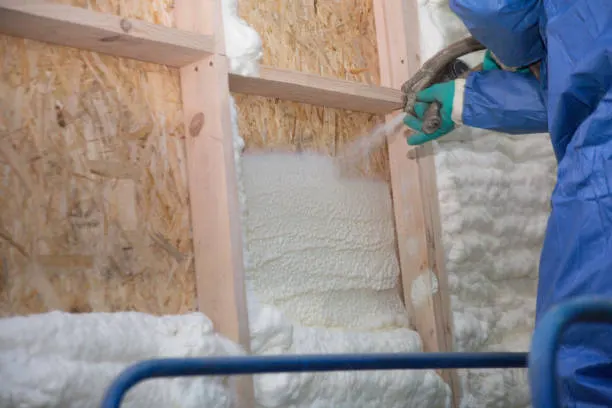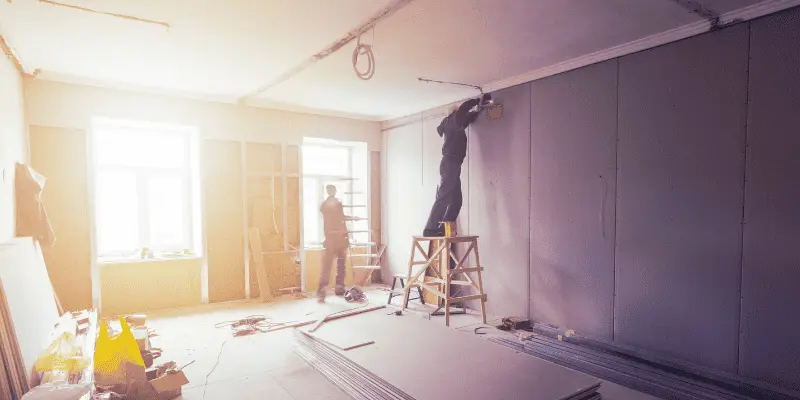
What are the disadvantages of spray foam insulation?
Spray foam insulation offers remarkable energy efficiency benefits, yet its initial installation costs may deter some homeowners. Unlike traditional insulation methods like fiberglass or cellulose, spray foam requires specialized equipment and professional expertise, contributing to its higher upfront expenses.
The primary factor influencing spray foam insulation costs is its application method. Unlike batt or roll insulation, which homeowners can easily install, spray foam insulation requires specialized equipment operated by trained professionals. These professionals carefully apply the foam to the desired areas, ensuring proper coverage and effectiveness. This specialized application process adds to the overall cost of Installation.
Spray foam insulation consists of two chemical components that, when combined, expand and harden to form an airtight seal. These chemicals undergo rigorous testing and certification to ensure quality and safety, contributing to their higher price point.
To mitigate the initial cost barrier, homeowners can explore financing options or take advantage of government incentives and rebates for energy-efficient home improvements. Even though spray foam insulation may cost more upfront than other techniques, its energy efficiency and long-term savings make it worth investing for homeowners trying to improve their homes' sustainability and comfort.
Spray foam insulation presents numerous benefits, but its application is best left to professionals due to significant DIY challenges. Unlike straightforward insulation methods like fiberglass batts or rolls, spray foam insulation demands specialized equipment and expertise.
The application process of spray foam insulation involves using high-pressure equipment to spray the foam onto surfaces evenly. Achieving proper coverage and thickness requires precision and experience, which professionals possess. With the necessary skills, homeowners can avoid uneven application, leading to insulation inefficiencies and potential air leaks.

Moreover, the chemicals used in spray foam insulation require careful handling and mixing. If not handled properly, these chemicals can be hazardous, posing health risks to inexperienced individuals. Professionals undergo rigorous training to ensure these chemicals' safe handling and application, mitigating potential health hazards.
Additionally, the equipment required for spray foam insulation application is costly and not readily available for DIY projects. Homeowners would need to invest in specialized spray equipment, safety gear, and protective clothing, adding to the project's overall expense.
Professional level
These professionals have the equipment, expertise, and safety measures to deliver high-quality insulation results, ultimately enhancing the home's comfort, energy efficiency, and value.
While spray foam insulation offers excellent benefits, such as energy efficiency, it's essential to be aware of potential health concerns associated with its Installation. Improper application or exposure to uncured chemicals during Installation can lead to respiratory issues and skin irritation.
During Installation, spray foam insulation undergoes a chemical reaction as it expands and hardens to form an airtight seal. If not applied correctly, the chemicals in the insulation may not cure properly, leading to the off-gassing of volatile organic compounds (VOCs). These VOCs can release harmful fumes into the air, causing respiratory problems such as coughing, wheezing, or difficulty breathing.
In addition to respiratory issues, exposure to uncured chemicals in spray foam insulation can irritate skin and mucous membranes. In severe cases, contact with uncured foam may cause skin irritation, redness, itching, or even chemical burns.
Certified insulation contractors have the expertise to apply spray foam insulation safely and Installation, reducing the likelihood of exposure to uncured chemicals.
By addressing health concerns associated with spray foam insulation and taking appropriate safety measures, homeowners can enjoy the energy-saving benefits of this insulation method while protecting their health and well-being.
While spray foam insulation provides effective thermal insulation for homes, its environmental impact must be considered. Some spray foam insulation products contain chemicals with high global warming potential (GWP), raising concerns about their contribution to climate change.
Two types of chemicals used in spray foam insulation, hydrofluorocarbons (HFCs) and hydrochlorofluorocarbons (HCFCs), have a significant potential to cause global warming (GWP). When these materials are released into the atmosphere, they trap heat, causing the greenhouse effect and global warming.
Additionally, the manufacturing process of spray foam insulation involves producing and transporting raw materials, which further contributes to its environmental footprint. Extracting and processing these materials may involve energy-intensive processes and produce greenhouse gas emissions.
To address environmental concerns associated with spray foam insulation, homeowners can opt for products that use alternative blowing agents with lower GWP values. Some manufacturers offer spray foam insulation formulations that utilize blowing agents with reduced environmental impact, such as hydrofluoroolefins (HFOs) or hydrocarbons.
Furthermore, proper installation and disposal practices can help minimize the environmental impact of spray foam insulation. Certified insulation contractors follow guidelines to reduce waste and ensure that leftover materials are disposed of responsibly.
For homeowners seeking more environmentally friendly alternatives to spray foam insulation, alternative insulation options, such as cellulose or mineral wool, may also be considered. These materials often have lower GWP values and may offer comparable thermal insulation properties.
By considering the environmental impact of spray foam insulation and exploring alternatives with lower GWP values, homeowners can make more informed decisions to reduce their carbon footprint and contribute to ecological sustainability.
If spray foam insulation is improperly installed or damaged, moisture issues can arise, leading to potential mold and mildew problems. When spray foam insulation is misapplied, gaps or voids may form, allowing moisture to infiltrate the building envelope. Additionally, if the insulation is damaged due to water intrusion or other factors, it may lose its effectiveness in preventing moisture buildup.
Proper Installation by experienced professionals is crucial to preventing installations associated with spray foam insulation. Certified Installation contractors have the expertise to ensure a seamless application, minimizing the risk of gaps or voids that could allow moisture infiltration.
Furthermore, homeowners should address existing water leaks or moisture problems before installing spray foam insulation. Proper drainage systems, vapor barriers, and waterproofing measures can help mitigate the risk of moisture buildup within the building envelope.
Regular inspection and insulation maintenance are also essential for preventing moisture-related issues. Homeowners should periodically check for signs of water damage, such as discoloration or sagging insulation, and address any problems promptly to avoid mold and mildew growth.
In regions with high humidity levels or prone to moisture problems, alternative insulation materials with better moisture resistance, such as closed-cell spray foam or rigid foam board, may be recommended.
By addressing moisture issues proactively and ensuring the proper Installation and maintenance of spray foam insulation, homeowners can enjoy the energy-saving benefits of insulation while safeguarding mold and mildew growth and maintaining a healthy indoor environment.
While effective, spray foam insulation poses a challenge regarding removal. Once applied, it forms a durable and adhesive seal that can be difficult to remove, making renovations or repairs more complicated and costly.
The adhesive nature of spray foam insulation means that removing it often requires specialized tools and equipment and extensive labor. In contrast to easily replaceable or removable insulation materials like loose-fill or fiberglass batts, spray foam sticks to surfaces tightly and is difficult to remove without causing damage.
Homeowners may need to hire professionals with experience in spray foam removal to ensure the job is done safely and effectively.
In some cases, the insulation may be tightly bonded to structural components, requiring careful extraction to avoid causing structural damage.
To mitigate the challenges of removing spray foam insulation, homeowners should consider their insulation options before Installation. Alternative insulation materials that are easier to remove or replace may be preferable for areas where renovations are anticipated in the future.
Additionally, proper planning and preparation can help minimize the need for spray foam insulation removal in the future. Ensuring access to utilities and maintaining clear pathways for future repairs can reduce the likelihood of needing to remove insulation during renovations.
Overall, while spray foam insulation offers excellent thermal performance, homeowners should be aware of its challenges when it comes to removal and plan accordingly to avoid complications and additional costs down the line.
Some spray foam insulation products have an issue with off-gassing because they can release volatile organic compounds (VOCs) during and after Installation, harming indoor air quality. VOCs are chemicals that can quickly install into the air, potentially causing respiratory and other health problems.
During Installation, spray foam insulation undergoes a chemical reaction as it expands and cures. TInstallation reaction releases VOCs into the air, leading to a phenomenon known as off-gassing. Additionally, even after the insulation has cured, some residual VOCs may continue to be released, especially in poorly ventilated areas.
Adequate ventilation helps to dissipate VOCs and improve indoor air quality. Homeowners should ensure that windows and doors are open during Installation and afterward to allow fresh air to circulate.
Furthermore, homeowners can spray foam insulation products with lower VOC emissions or those certified low-VOC by reputable organizations. These products are formulatedInstallation off-gassing and reduce the impact on indoor air quality.
Regular indoor air quality monitoring is also recommended to detect any issues related to off-gassing from spray foam insulation or other sources.
FAQs
1. What is spray foam insulation?
Spray foam insulation is a liquid substance that expands to cover and seal cracks and spaces in walls, ceilings, and other surfaces. It enhances building energy efficiency and offers superior thermal insulation.
2. How does spray foam insulation work?
With the aid of specialist equipment, two chemical components are mixed to create spray foam insulation, which expands quickly when it comes into contact with surfaces. By developing, the foam can fill spaces and form an airtight seal that stops leaks and heat transfer.
3. What are the benefits of spray foam insulation?
Spray foam insulation offers several benefits, including superior thermal performance, improved energy efficiency, and enhanced indoor comfort.
4. Are there different types of spray foam insulation?
Yes, spray foam insulation comes in two primary varieties: closed-cell and open-cell. Open-cell spray foam offers enhanced flexibility and acoustic absorption due to its decreased weight and reduced density. Closed-cell spray foam is denser and provides stronger structural support, making it ideal for areas prone to moisture or humidity.
5. Is spray foam insulation safe?
When appropriately installed by trained professionals, spray foam insulation is considered safe. However, following safety guidelines during Installation and ensuring proper ventilation to minimize exposure to off-gassing chemicals is essential. Homeowners should also choose products with low VOC emissions for improved indoor air quality.
Conclusion
In conclusion, spray foam installation significantly benefits homeowners, including improved energy efficiency, enhanced indoor comfort, and better insulation performance. However, potential drawbacks such as higher initial costs, health concerns related to off-gassing, and challenges with removal must be considered.
Despite these drawbacks, the advantages of spray foam insulation often outweigh the disadvantages, especially when appropriately installed by trained professionals.
By taking these steps, homeowners can make the most of spray foam insulation while addressing installations and ensuring a positive outcome for their home insulation projects. Simply contact us without any delay.
Reach Out To Spray Foam Insulation Westminster
Delivering Quality Insulation Solutions in Westminster, Colorado
Call us today!